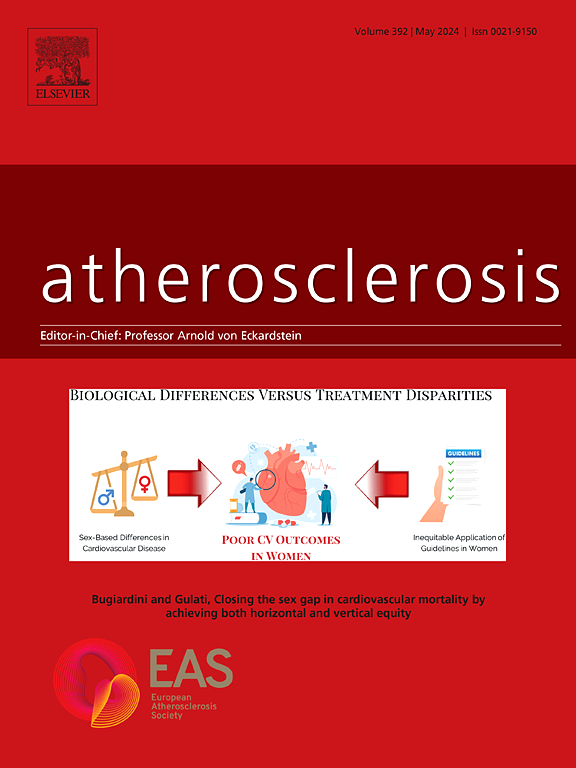Global deletion of the LXR-regulated gene EEPD1 reveals macrophage-specific changes in lipid metabolism and cholesterol efflux
IF 4.9
2区 医学
Q1 CARDIAC & CARDIOVASCULAR SYSTEMS
引用次数: 0
Abstract
Background and aims
We recently reported that Endonuclease/Exonuclease/Phosphatase family Domain containing 1 (EEPD1) is a transcriptional target of the sterol-responsive nuclear Liver X Receptors (LXR) in macrophages. The aim of this study is to clarify the in vivo role of EEPD1 in whole-body and macrophage lipid handling, and in the development of atherosclerosis.
Methods
We developed mice with global deletion of Eepd1 and challenged them with a high-fat- and a Western-type diet. Bone marrow-derived macrophages (BMDM) were used for profiling transcriptomic and lipidomic changes, and evaluating cholesterol efflux in the absence of Eepd1. We transplanted bone marrow from wildtype and Eepd1KO mice into LdlrKO recipients to assess the role of myeloid-specific EEPD1 in atherogenesis.
Results
Eepd1KO mice were indistinguishable from wildtype controls when fed a low-fat diet. However, when challenged with a high-fat diet or a cholesterol-containing western diet, Eepd1KO displayed enhanced weight gain, with no evident changes in plasma and hepatic lipid levels observed. Consistent with our earlier report, BMDM isolated from Eepd1KO mice had attenuated LXR-stimulated cholesterol efflux to high density lipoprotein and Apolipoprotein A1 when compared to wildtype cells. The transcriptomic and lipidomic landscape of these cells revealed a small reduction in expression of cholesterol biosynthetic genes in LXR-stimulated Eepd1KO cells, and prominent changes in diacylglycerol and hexosylceramides level and species. Changes were also observed in triglyceride and cholesterol-ester species. Myeloid-specific loss of Eepd1 did not alter atherosclerotic plaque size and collagen content in bone marrow-transplanted LdlrKO recipients.
Conclusions
Loss of Eepd1 results in an altered lipidomic landscape and reduced LXR-stimulated cholesterol efflux in BMDM, but myeloid-specific loss of Eepd1 does not influence atherogenesis in mice.

lxr调控基因EEPD1的全局缺失揭示了巨噬细胞特异性脂质代谢和胆固醇外排的变化
背景和目的我们最近报道了含有1内切酶/外切酶/磷酸酶家族结构域(EEPD1)是巨噬细胞中固醇反应性核肝X受体(LXR)的转录靶点。本研究的目的是阐明EEPD1在全身和巨噬细胞脂质处理以及动脉粥样硬化发展中的体内作用。方法培养Eepd1全域缺失小鼠,并给予高脂肪和西式饮食。骨髓源性巨噬细胞(BMDM)用于分析转录组学和脂质组学变化,并评估在缺乏Eepd1的情况下胆固醇外排。我们将野生型和Eepd1KO小鼠的骨髓移植到LdlrKO受体中,以评估骨髓特异性EEPD1在动脉粥样硬化中的作用。结果低脂喂养的epd1ko小鼠与野生型对照组无明显差异。然而,当用高脂肪饮食或含胆固醇的西方饮食挑战时,Eepd1KO表现出体重增加,血浆和肝脏脂质水平没有明显变化。与我们之前的报道一致,与野生型细胞相比,从Eepd1KO小鼠中分离的BMDM减少了lxr刺激的胆固醇向高密度脂蛋白和载脂蛋白A1的外泄。这些细胞的转录组学和脂质组学显示,在lxr刺激的Eepd1KO细胞中,胆固醇生物合成基因的表达略有减少,二酰基甘油和己糖神经酰胺的水平和种类发生了显著变化。甘油三酯和胆固醇酯种类也发生了变化。骨髓特异性Eepd1的缺失并未改变骨髓移植ldl - rko受体的动脉粥样硬化斑块大小和胶原含量。结论Eepd1的缺失导致BMDM中脂质组学格局的改变和lxr刺激的胆固醇外流减少,但骨髓特异性Eepd1的缺失不会影响小鼠动脉粥样硬化的发生。
本文章由计算机程序翻译,如有差异,请以英文原文为准。
求助全文
约1分钟内获得全文
求助全文
来源期刊

Atherosclerosis
医学-外周血管病
CiteScore
9.80
自引率
3.80%
发文量
1269
审稿时长
36 days
期刊介绍:
Atherosclerosis has an open access mirror journal Atherosclerosis: X, sharing the same aims and scope, editorial team, submission system and rigorous peer review.
Atherosclerosis brings together, from all sources, papers concerned with investigation on atherosclerosis, its risk factors and clinical manifestations. Atherosclerosis covers basic and translational, clinical and population research approaches to arterial and vascular biology and disease, as well as their risk factors including: disturbances of lipid and lipoprotein metabolism, diabetes and hypertension, thrombosis, and inflammation. The Editors are interested in original or review papers dealing with the pathogenesis, environmental, genetic and epigenetic basis, diagnosis or treatment of atherosclerosis and related diseases as well as their risk factors.
 求助内容:
求助内容: 应助结果提醒方式:
应助结果提醒方式:


